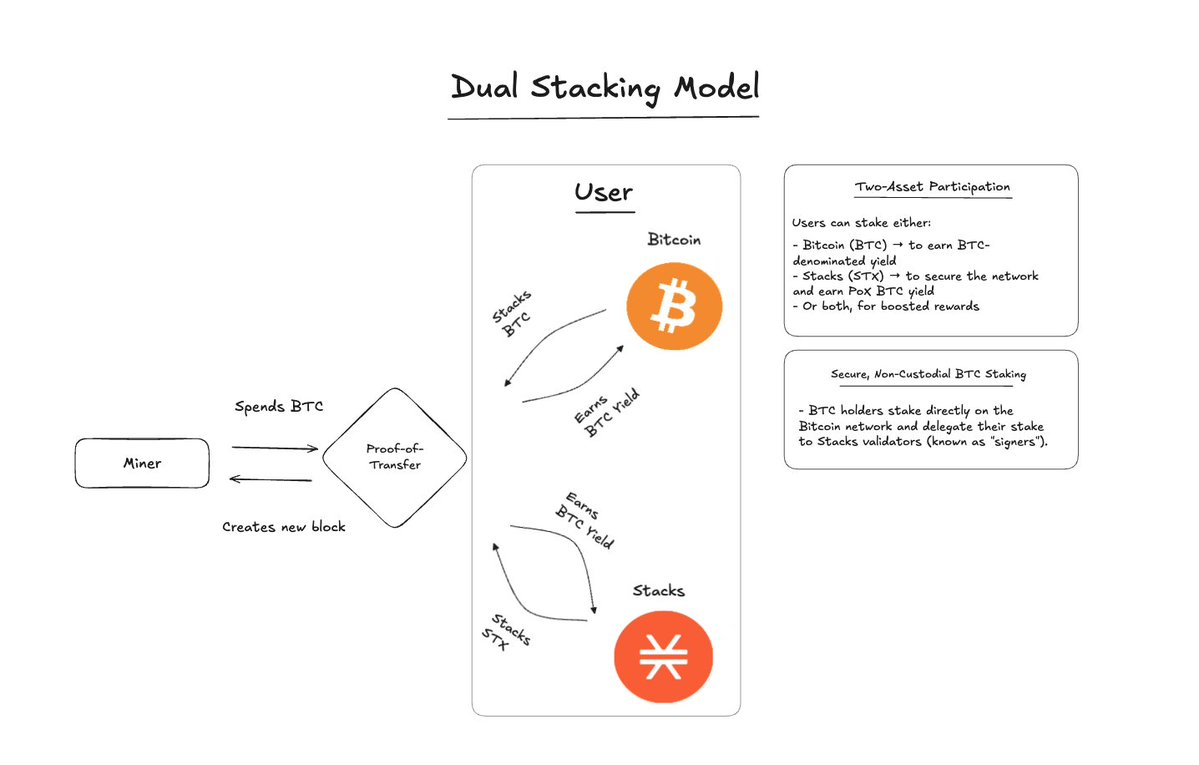Core contributors to Bitcoin L2 Stacks are advancing an economic upgrade that lets every surge of Bitcoin activity on Stacks automatically strengthen Stacks and reward STX holders.
At its center is sBTC, the L2 BTC asset already making more than 5,000 BTC productive and designed to scale to millions. Three near-term engines (native Bitcoin-denominated staking yield via dual stacking, institutional Bitcoin DeFi, and fast Bitcoin payments) will fuel adoption.
Dual Stacking
The contributors’ Dual Stacking design proposal lets users stake BTC, STX, or both; pairing STX with BTC multiplies BTC rewards, binding capital inflow, network security, and token demand into a single flywheel. Programmable BTC vaults add one-click “BTC in, yield out” strategies, further opening yield products to retail and institutional investors alike.
sBTC as gas
To remove onboarding friction, fee abstraction lets users pay gas in sBTC while the protocol converts and burns (or treasury-routes) the equivalent STX under the hood, preserving STX as the gas token yet capturing value from every transaction. Institutional liquidity is unlocked through qualified-custody minting: regulated custodians deposit BTC to Stacks via segregated multisig, bringing compliant capital without sacrificing composability.
Fully Trustless sBTC
Research continues toward fully trustless, non-custodial sBTC. A forthcoming self-custodial minting design will let users (or qualified custodians) sign every transaction that could move their underlying BTC, eliminating custodial risk via zero-knowledge proofs, HTLCs, and a Redemption DAG that tracks ownership on L2.
Complementary Bitcoin-level post-conditions will allow smart contracts to dictate how the underlying BTC may move, unlocking use cases like programmatic liquidations while maintaining unilateral exit guarantees. Collectively, these upgrades position Stacks as Bitcoin’s long-term liquidity layer, scalable, revenue-generating, and aligned with Bitcoin’s core principles.
Roadmap Context
In parallel, core developers are targeting sub-10-second confirmations and higher throughput via network optimizations and future consensus tweaks, while a Clarity-to-Wasm compiler slated for Q3 2025 lays the groundwork for faster, more efficient smart contracts. Simplified, auto-renewing Stacking, Ledger Live integration, and PoX v5 research, all reinforce the flywheel: better performance and UX attract more BTC liquidity, which, through the economic model above, feeds directly back into STX value accrual.
Sources
1) For full STX economic model post, see Stacks Forum: Stacks Economic Model: Unlocking Bitcoin Capital & Long-Term Growth.
2) For full roadmap: stacksroadmap(.)com
3) For full satoshi upgrades whitepaper: stacksroadmap(.)com/satoshi
Post is based on recently published proposals and initiatives by core contributors in the Stacks ecosystem.

187
42.64K
The content on this page is provided by third parties. Unless otherwise stated, OKX is not the author of the cited article(s) and does not claim any copyright in the materials. The content is provided for informational purposes only and does not represent the views of OKX. It is not intended to be an endorsement of any kind and should not be considered investment advice or a solicitation to buy or sell digital assets. To the extent generative AI is utilized to provide summaries or other information, such AI generated content may be inaccurate or inconsistent. Please read the linked article for more details and information. OKX is not responsible for content hosted on third party sites. Digital asset holdings, including stablecoins and NFTs, involve a high degree of risk and can fluctuate greatly. You should carefully consider whether trading or holding digital assets is suitable for you in light of your financial condition.

